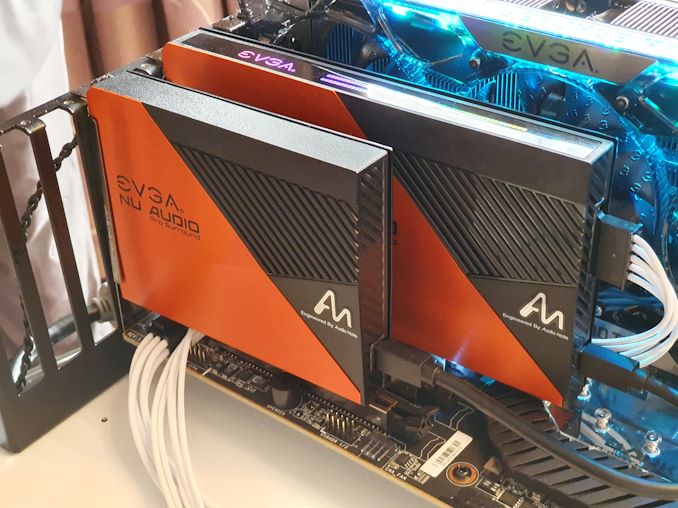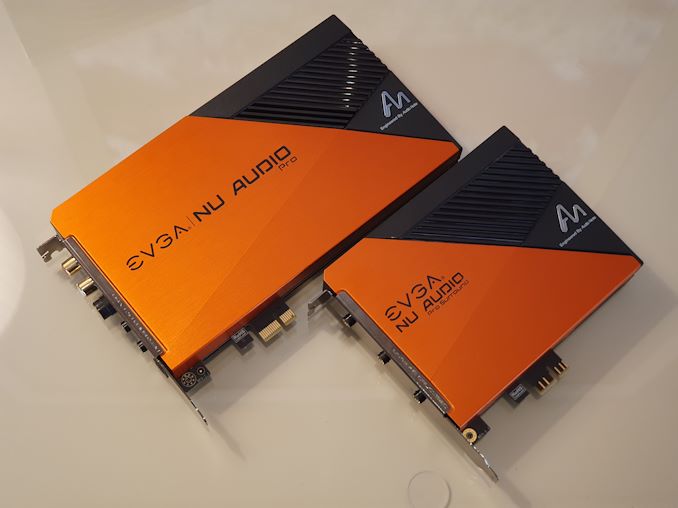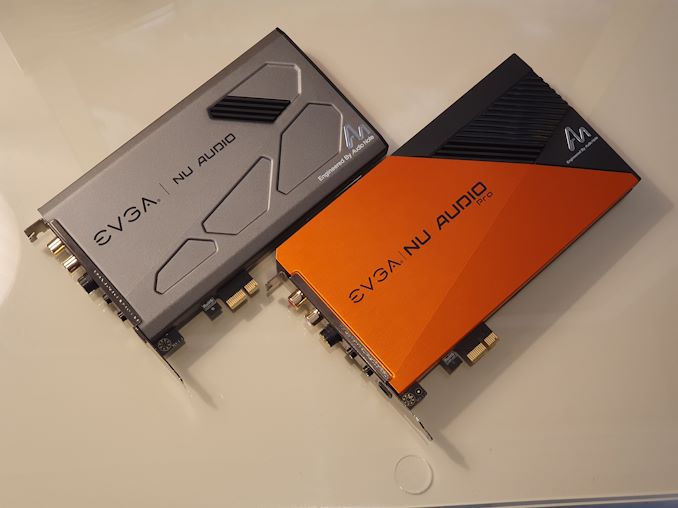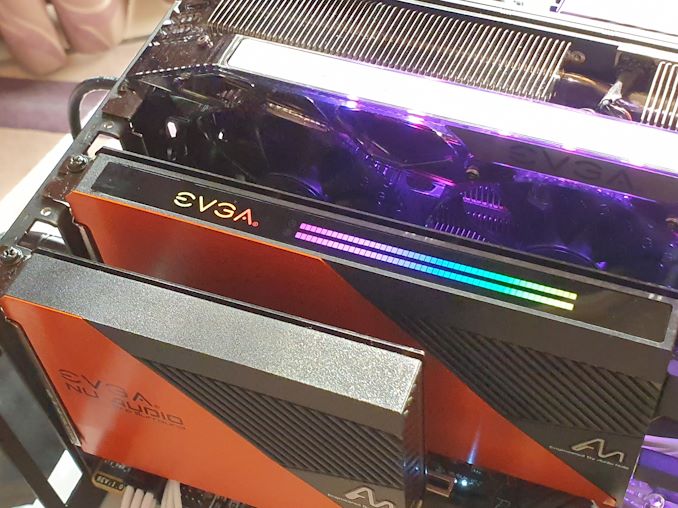CES 2020: EVGA Showcases New Nu Audio Pro Card
by Andrei Frumusanu on January 10, 2020 12:00 PM EST
Initially announced last November, EVGA at CES 2020 showcased the new second generation Nu Audio Pro audio card. The latest model improves upon its predecessor in several ways, including adding 7.1 channel output option, as well as adding RGB lighting. Overall, EVGA remains a relative newcomer to the sound card market, with the company having started off its journey with the original Nu Audio last year, targeting the more niche high-end internal audio solution market.
The new Nu Audio Pro improves upon the first generation in terms of component choices; it still contains the same XMOS xCORE-200 DSP accompanied by Asahi Kasei Microdevices’ (AKM) AK4493 DAC, the AKM AK5572 ADC, and the Cirrus Logic CS5346 ADC. But it’s said that the supporting analog components have been improved so the new characteristics of the card are enhanced.
Design-wise, we’re also seeing a refresh as the new card now sports a red-black finish, and it has hopped on the RGB train with side-mounted LED strips that can be animated and synced with audio playback.
The main board is a straightforward replacement to last year’s model and comes at a $199 price tag.

Nu Audio Pro & Nu Audio Pro Surround
Instead, what’s special for EVGA's audio card this year is the introduction of a second daughter board that allows for 7.1 channel audio playback. The second board has three additional outputs and is fully self-contained in terms of the audio signal generation, including its own DACs. The interface between the card is digital via a repurposed DisplayPort connector between the two boards. The daughterboard’s PCIe connector just serves as grounding as well as structural support – in theory you can have this free-floating instead of having it take up a PCIe slot on your motherboard, but there might be degradations due to possible lesser grounding.
The full Nu Audio Pro kit with the 7.1 add-on card can be had for $299; otherwise the boards are sold separately for $199 and $119 respectively, with availability set in the comings months. Overall, EVGA tells us that they’re continuing to iterate on their designs, and that the company is also investigating the development of an external USB version of the card (The PCIe versions actually use a PCIe to USB bridge internally for connectivity) in the future.












39 Comments
View All Comments
willis936 - Friday, January 10, 2020 - link
If you’re looking for a low noise, low bandwidth oscilloscope, they’re great.Samus - Friday, January 10, 2020 - link
Sadly, most of the integrated audio on motherboards now is worse than it was 15 years ago. Back then you could get Envy24-class (VIA, Cirrus Logic, etc) equivalent codec's and Wolfson DAC's integrated into a board. Now it seems 99% of the market has some basic Realtek BS.PeachNCream - Friday, January 10, 2020 - link
Its a product of reaching a state of good enough and a general sense of apathy among the broader market. A small number of people concern themselves with audio quality and are this interested in computer technology (and happen to own a desktop PC) that would lay down additional money for a dedicated audio solution. Products like these would be available from a larger number of companies and get more press attention if they were more mainstream. Don't get me wrong - chasing better audio quality is fine if that's someone's interest, but I'm just saying it simply isn't a big deal for most of us beyond getting a decent pair of headphones or an okay sounding set of speakers.CaedenV - Sunday, January 12, 2020 - link
Same. These cards are less than useless. On my old system I had a cheap $15 USB sound card, and the quality improvement of getting the DAC part of the chain outside of the case made me happy as a clam.Last year I bought a phone without a headphone jack, so I got a fairly nice BT headset, and while the quality is frankly not as good as wired, it is still very nice. But most of the time I am outputing my audio through my GPU's HDMI out, through the TV, and ARC to a sound bar. There is just no 'sound card' in the chain, and the audio is clean and good quality. Again, happier than I have ever been with any $250 Audigy card that I ever owned in the past where I could still point to specific audio issues in the chain.
Down side, is that both the headphones and ARC limit me to stereo... Really hoping my next TV/monitor and sound bar will have eARC with true surround sound options, and that Windows gives it proper support.
Korguz - Monday, January 13, 2020 - link
CaedenV " These cards are less than useless" for you... for others.. they are worth it to them." But most of the time I am outputing my audio through my GPU's HDMI out " that works for you.. but for me, i'll stick to the DD/DTS surround sound my creative Soundblaster Z, and various Auzentech cards are able to encode to.
tygrus - Monday, January 13, 2020 - link
You still have the part of a sound card that matters, the DAC in the sound bar to it's internal amplifier(s).jeremyshaw - Friday, January 10, 2020 - link
Why wasn't this just a dual slot card, instead of two cards that each require a PCIe slot (or some part of)?Desierz - Saturday, January 11, 2020 - link
Because they sell them separately.Kakti - Wednesday, January 15, 2020 - link
Next time can we please get at least one picture showing the outputs? We don't really need two pictures of the top or two of the side if there's not even one showing the arrangement and types of outputs.